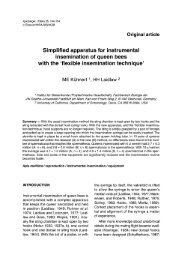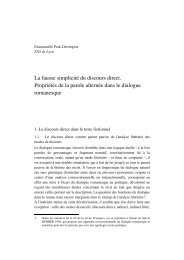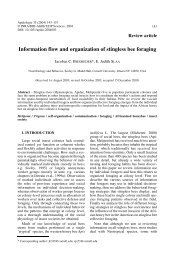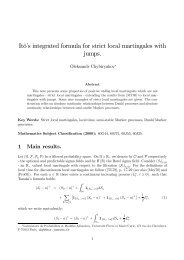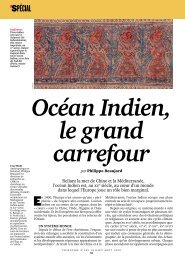Itineraries of Palestinian refugees: Kinship as resource in emigration.
Itineraries of Palestinian refugees: Kinship as resource in emigration.
Itineraries of Palestinian refugees: Kinship as resource in emigration.
Create successful ePaper yourself
Turn your PDF publications into a flip-book with our unique Google optimized e-Paper software.
halshs-00342285, version 1 - 28 Nov 2008<br />
Author manuscript, published <strong>in</strong> "Cross<strong>in</strong>g Borders, Shift<strong>in</strong>g Boundaries. <strong>Palest<strong>in</strong>ian</strong> Dilemn<strong>as</strong>., Sari Hanafi (Ed.) (2008) 85-104"<br />
Chapter 5<br />
<strong>It<strong>in</strong>eraries</strong> <strong>of</strong> <strong>Palest<strong>in</strong>ian</strong> <strong>refugees</strong>: <strong>K<strong>in</strong>ship</strong> <strong>as</strong> <strong>resource</strong> <strong>in</strong> <strong>emigration</strong>.<br />
Mohamed Kamel Doraï<br />
I- Introduction: The Development <strong>of</strong> Emigration.<br />
A social world is not conf<strong>in</strong>ed to a particular<br />
place or limited by territorial boundaries. Some<br />
<strong>of</strong> the relationships may be very important, but<br />
physically distant, while others may be almost<br />
<strong>in</strong>significant although located close by. What is<br />
important is which social relationships play a<br />
role <strong>in</strong> a particular situation (E. Marx 1990:<br />
194).<br />
Today, even if some <strong>Palest<strong>in</strong>ian</strong>s are still forced to move from their place <strong>of</strong><br />
residence (e.g. <strong>Palest<strong>in</strong>ian</strong>s expelled from Kuwait <strong>in</strong> 1991, from Libya <strong>in</strong> 1995 and <strong>in</strong>side<br />
the Occupied Territories), <strong>Palest<strong>in</strong>ian</strong> migration develops <strong>in</strong>side the Di<strong>as</strong>pora on a more<br />
or less ‘voluntary’ b<strong>as</strong>is, connect<strong>in</strong>g distant poles such <strong>as</strong> North America or Europe.<br />
Parallel to this ‘voluntary migration’ movement, a ‘forced return’ movement occurred.<br />
For example, <strong>Palest<strong>in</strong>ian</strong>s who migrated to Iraq to work and study had to leave because <strong>of</strong><br />
war and its economic and political consequences. These different types <strong>of</strong> migration obey<br />
regional and state constra<strong>in</strong>ts <strong>as</strong> well <strong>as</strong> dynamics generated by <strong>Palest<strong>in</strong>ian</strong>s themselves<br />
and rely upon migratory networks set up on local and familial b<strong>as</strong>es. Studies <strong>of</strong><br />
<strong>Palest<strong>in</strong>ian</strong> <strong>refugees</strong>, one <strong>of</strong> the oldest refugee communities <strong>in</strong> the world, could contribute<br />
to the grow<strong>in</strong>g <strong>in</strong>terest on <strong>in</strong>tegrat<strong>in</strong>g refugee studies to the wider field <strong>of</strong> migration<br />
theory (Koser 2002).<br />
1
halshs-00342285, version 1 - 28 Nov 2008<br />
This paper deals with the situation <strong>of</strong> the <strong>Palest<strong>in</strong>ian</strong> <strong>refugees</strong> <strong>in</strong> Lebanon. S<strong>in</strong>ce<br />
the 1970s, more than 100,000 <strong>Palest<strong>in</strong>ian</strong>s 1 – about 25% <strong>of</strong> the total <strong>Palest<strong>in</strong>ian</strong><br />
population resid<strong>in</strong>g <strong>in</strong> Lebanon - have emigrated from Lebanon to the Gulf countries and<br />
Northern Europe, ma<strong>in</strong>ly Germany, Sweden and Denmark. Consider<strong>in</strong>g the organization<br />
<strong>of</strong> <strong>Palest<strong>in</strong>ian</strong> <strong>emigration</strong> from Lebanon to Europe, from the 1960s to today, and<br />
particularly the migratory networks from the Tyre region <strong>in</strong> Lebanon to Europe and Iraq,<br />
and b<strong>as</strong>ed on <strong>in</strong>terviews with <strong>refugees</strong> <strong>in</strong> south Lebanon and Sweden, a certa<strong>in</strong> picture<br />
emerges. Until 1987, many <strong>Palest<strong>in</strong>ian</strong>s fled Lebanon and obta<strong>in</strong>ed refugee status <strong>in</strong><br />
Europe. Dur<strong>in</strong>g the 1970s and the 1980s a smaller group <strong>of</strong> <strong>Palest<strong>in</strong>ian</strong>s also went to<br />
work and study <strong>in</strong> Iraq. After 1987, Europe gradually closed its borders to <strong>Palest<strong>in</strong>ian</strong><br />
<strong>refugees</strong>, while the situation <strong>in</strong> Lebanon grew worse. The community tensions <strong>in</strong><br />
Lebanon, which were exacerbated dur<strong>in</strong>g the Lebanese civil war, culm<strong>in</strong>ated <strong>in</strong> 1985-<br />
1987 with the war <strong>of</strong> the camps 2 . The Amal militia tried to make <strong>Palest<strong>in</strong>ian</strong>s flee the<br />
Tyree area, which they wanted to make a Shiite canton. A large majority <strong>of</strong> <strong>Palest<strong>in</strong>ian</strong>s<br />
did <strong>in</strong>deed flee towards Sidon, the nearest Sunnite city. But most <strong>of</strong> them came back to<br />
Tyre at the end <strong>of</strong> the Lebanese civil war <strong>in</strong> 1991. Dur<strong>in</strong>g the 1990s, four ma<strong>in</strong> factors led<br />
to the development <strong>of</strong> <strong>emigration</strong>: (1) the end <strong>of</strong> the civil war <strong>in</strong> Lebanon <strong>in</strong>cre<strong>as</strong>ed the<br />
discrim<strong>in</strong>ation aga<strong>in</strong>st the <strong>Palest<strong>in</strong>ian</strong> community at the political and economic levels, (2)<br />
the Oslo agreement did not provide any solution, nor any prospects <strong>of</strong> one, for the 1948<br />
<strong>refugees</strong>, (3) the economic situation <strong>in</strong> Lebanon w<strong>as</strong> gett<strong>in</strong>g worse <strong>in</strong> 1993, and (4)<br />
<strong>Palest<strong>in</strong>ian</strong>s were compet<strong>in</strong>g with Syrian and Egyptian workers <strong>in</strong> the labor market. In the<br />
absence <strong>of</strong> the implementation <strong>of</strong> their ‘right <strong>of</strong> return’, <strong>Palest<strong>in</strong>ian</strong>s from Lebanon<br />
looked for a better economic situation, a recognized legal status, and a country where<br />
1 In his statistical overview <strong>of</strong> <strong>Palest<strong>in</strong>ian</strong>s <strong>in</strong> Lebanon, Razqallah (1998) gives the number <strong>of</strong><br />
100,000 <strong>Palest<strong>in</strong>ian</strong>s from Lebanon liv<strong>in</strong>g abroad <strong>in</strong> the mid-1990s. This estimation fits the<br />
statistics available on <strong>Palest<strong>in</strong>ian</strong>s <strong>in</strong> Europe, where about 18,000 <strong>Palest<strong>in</strong>ian</strong>s live <strong>in</strong> Sweden <strong>in</strong><br />
2006 accord<strong>in</strong>g to the Migrationsverket<br />
[http://www.migrationsverket.se/pdffiler/statistik/tabe2.pdf]; 12,000 <strong>in</strong> Denmark (Danish<br />
Immigration Service, 2001); probably 30,000 <strong>in</strong> Germany (this l<strong>as</strong>t number is a personal<br />
estimation b<strong>as</strong>ed on <strong>in</strong>terviews), the majority <strong>of</strong> these <strong>Palest<strong>in</strong>ian</strong>s hold Lebanese travel<br />
documents. The rest <strong>of</strong> the <strong>Palest<strong>in</strong>ian</strong>s from Lebanon who live abroad are settled <strong>in</strong> Arabic oil<br />
produc<strong>in</strong>g countries. However, s<strong>in</strong>ce most <strong>of</strong> the recent <strong>emigration</strong> towards Europe is illegal, it is<br />
very difficult to give reliable figures on actual <strong>Palest<strong>in</strong>ian</strong> <strong>emigration</strong> from Lebanon s<strong>in</strong>ce the<br />
1990s.<br />
2 Between the Shiite Lebanese militia Amal and the <strong>Palest<strong>in</strong>ian</strong> refugee camp dwellers.<br />
2
halshs-00342285, version 1 - 28 Nov 2008<br />
they could build a "normal" life for their children. On a regional scale, due to war, tension<br />
and economic closures Iraq became less attractive to new Arab immigrants. <strong>Palest<strong>in</strong>ian</strong>s<br />
already settled there began to face economic difficulties but also discrim<strong>in</strong>ation.<br />
The 1982 Israeli <strong>in</strong>v<strong>as</strong>ion triggered <strong>Palest<strong>in</strong>ian</strong> <strong>emigration</strong> from Lebanon, but this<br />
alone cannot expla<strong>in</strong> its duration nor its size. This paper will analyze how <strong>Palest<strong>in</strong>ian</strong><br />
<strong>refugees</strong>, deprived <strong>of</strong> p<strong>as</strong>sport and f<strong>in</strong>ancial <strong>resource</strong>s, have managed to leave their<br />
country <strong>of</strong> residence and enter Western Europe. One <strong>of</strong> the key hypotheses is the<br />
follow<strong>in</strong>g: <strong>Palest<strong>in</strong>ian</strong> <strong>refugees</strong> <strong>in</strong> the refugee camps and the <strong>in</strong>formal settlements 3 <strong>in</strong><br />
Lebanon have reconstructed systems <strong>of</strong> solidarity b<strong>as</strong>ed on k<strong>in</strong>ship and local networks.<br />
These networks, developed at a local level, have been turned <strong>in</strong>to transnational networks<br />
<strong>of</strong> solidarity by migrant communities, build<strong>in</strong>g bridges between <strong>Palest<strong>in</strong>ian</strong>s <strong>in</strong> Lebanon<br />
and migrants abroad. Resources such <strong>as</strong> money, <strong>in</strong>formation on dest<strong>in</strong>ation countries,<br />
legal constra<strong>in</strong>ts or opportunities, circulate through these networks, l<strong>in</strong>k<strong>in</strong>g potential<br />
migrants to <strong>Palest<strong>in</strong>ian</strong>s settled <strong>in</strong> Europe. These networks facilitate <strong>refugees</strong>’ mobility,<br />
<strong>in</strong> a context <strong>of</strong> difficult legal constra<strong>in</strong>ts <strong>in</strong> Europe, and a lack <strong>of</strong> f<strong>in</strong>ancial <strong>resource</strong>s <strong>in</strong><br />
Lebanon. <strong>Palest<strong>in</strong>ian</strong>s had to organize themselves to get around those difficulties. They<br />
used their transnational <strong>resource</strong>s, such <strong>as</strong> their close contacts with the <strong>Palest<strong>in</strong>ian</strong><br />
communities liv<strong>in</strong>g abroad and the migratory networks they constructed <strong>in</strong> the 1980s, to<br />
facilitate <strong>emigration</strong>. Transnationalism developed by <strong>Palest<strong>in</strong>ian</strong> <strong>refugees</strong> h<strong>as</strong> to be<br />
considered ma<strong>in</strong>ly <strong>as</strong> a strategy to escape a highly restrictive regional environment,<br />
especially <strong>in</strong> Lebanon. Migratory networks, b<strong>as</strong>ed on family ties, are also one <strong>of</strong> the few<br />
<strong>resource</strong>s accessible to return migrants who were forced to leave Iraq and come back to<br />
Lebanon without <strong>in</strong>ternational <strong>as</strong>sistance.<br />
This paper is structured <strong>as</strong> follows. Firstly, I will explore, <strong>in</strong> a theoretical<br />
perspective, the usefulness <strong>of</strong> analyz<strong>in</strong>g the diversity <strong>of</strong> migratory refugee experiences<br />
and the build<strong>in</strong>g <strong>of</strong> transnational networks. Secondly, I will present different migratory<br />
3 Informal settlements are un<strong>of</strong>ficial refugee camps, built up by the <strong>refugees</strong> themselves, mostly<br />
on private Lebanese land without authorization <strong>of</strong> Lebanese authorities. Most <strong>of</strong> them are<br />
concentrated <strong>in</strong> rural are<strong>as</strong>.<br />
3
halshs-00342285, version 1 - 28 Nov 2008<br />
it<strong>in</strong>eraries collected dur<strong>in</strong>g various fieldwork trips <strong>in</strong> Lebanon to show the different use<br />
<strong>of</strong> transnational networks and access to <strong>resource</strong>s.<br />
II. Towards a comprehensive approach to <strong>Palest<strong>in</strong>ian</strong> Di<strong>as</strong>pora migration.<br />
Many studies on <strong>Palest<strong>in</strong>ian</strong> <strong>refugees</strong> have explored the fields <strong>of</strong> memory (e.g.<br />
Khalidi 1991) and national formation (e.g. Brand 1998). More recently, with the<br />
beg<strong>in</strong>n<strong>in</strong>g <strong>of</strong> the peace process <strong>in</strong> 1991, research h<strong>as</strong> been conducted on the refugee<br />
question, their legal status and their number (Abu-Sitta 2001; Tamari 1996; Zureik 1996).<br />
Only a few studies have been published on the new forms <strong>of</strong> social organization <strong>in</strong> the<br />
<strong>Palest<strong>in</strong>ian</strong> refugee communities abroad (e.g. Hanafi 2001; Radi 1995). Nevertheless, the<br />
diversity and the complexity <strong>of</strong> refugee experiences have to be explored.<br />
II.1. From <strong>refugees</strong> to migrants?<br />
Network analysis provides an <strong>in</strong>terest<strong>in</strong>g framework that goes beyond the<br />
juridical analysis, imposed by the term ‘refugee’ itself whose orig<strong>in</strong> is deeply rooted <strong>in</strong><br />
<strong>in</strong>ternational law. The <strong>Palest<strong>in</strong>ian</strong> experience is a good illustration <strong>of</strong> this. More than fifty<br />
years <strong>of</strong> exile have generated a wide range <strong>of</strong> different situations, from stateless <strong>refugees</strong><br />
still liv<strong>in</strong>g <strong>in</strong> poor refugee camps <strong>in</strong> Middle E<strong>as</strong>t countries to rich <strong>in</strong>vestors hold<strong>in</strong>g Gulf<br />
or Western citizenship. A huge diversity <strong>of</strong> social, legal and economic statuses and<br />
personal backgrounds coexist <strong>in</strong>side the category "<strong>Palest<strong>in</strong>ian</strong> refugee". As Liisa Malkki<br />
(1995: 496) po<strong>in</strong>ted out:<br />
‘Refugees’ do not constitute a naturally self-delimit<strong>in</strong>g doma<strong>in</strong> <strong>of</strong><br />
anthropological knowledge. Forced population movements have<br />
extraord<strong>in</strong>arily diverse historical and political causes and <strong>in</strong>volve<br />
people who, while all displaced, f<strong>in</strong>d themselves <strong>in</strong> qualitatively<br />
different situations and predicaments. Thus, it would seem that the term<br />
4
halshs-00342285, version 1 - 28 Nov 2008<br />
‘refugee’ h<strong>as</strong> analytical usefulness not <strong>as</strong> a label for a special,<br />
generalizable ‘k<strong>in</strong>d’ or ‘type’ <strong>of</strong> person or situation, but only <strong>as</strong> a broad<br />
legal or descriptive rubric that <strong>in</strong>cludes with<strong>in</strong> it a world <strong>of</strong> different<br />
socio-economic statuses, personal histories, and psychological or<br />
spiritual situations. Involuntary or forced movements <strong>of</strong> people are<br />
always only one <strong>as</strong>pect <strong>of</strong> much larger constellations <strong>of</strong> sociopolitical<br />
and cultural processes and practices.<br />
II.2. Refugees and migration theories<br />
Early attempts to build a general theoretical model <strong>of</strong> refugee issues have focused<br />
ma<strong>in</strong>ly on push factors to expla<strong>in</strong> refugee movements (Kunz 1973, 1981). More recent<br />
studies have emph<strong>as</strong>ized the role <strong>of</strong> <strong>in</strong>ternational relations <strong>in</strong> the production <strong>of</strong> refugee<br />
flows (Loescher 1990; We<strong>in</strong>er 1993). If push factors <strong>as</strong> well <strong>as</strong> <strong>in</strong>ternational politics are<br />
key issues for the understand<strong>in</strong>g <strong>of</strong> refugee movements, little attention h<strong>as</strong> been paid to<br />
dynamics generated by the <strong>refugees</strong> themselves. The duration <strong>of</strong> exile and the different<br />
k<strong>in</strong>d <strong>of</strong> <strong>in</strong>teractions with the host societies have also generated different forms <strong>of</strong><br />
mobility. Richmond (1994: 55) stresses that:<br />
[…] the dist<strong>in</strong>ction between free and forced or voluntary and<br />
<strong>in</strong>voluntary is a mislead<strong>in</strong>g one. All human behavior is constra<strong>in</strong>ed.<br />
Choices are not unlimited but are determ<strong>in</strong>ed by the structuration<br />
process. However, degrees <strong>of</strong> freedom may vary. Individual and group<br />
autonomy and potency are situationally determ<strong>in</strong>ed. It would be more<br />
appropriate to recognize a cont<strong>in</strong>uum at one end <strong>of</strong> which <strong>in</strong>dividuals<br />
and collectivities are proactive and at the other reactive.<br />
Seteney Shami (1993: 12) notes that <strong>in</strong> the Middle E<strong>as</strong>t this dist<strong>in</strong>ction between<br />
forced migration and voluntary migration is not always relevant. The author suggests that<br />
5
halshs-00342285, version 1 - 28 Nov 2008<br />
"displacement <strong>of</strong>ten leads to labor migration <strong>as</strong> a cop<strong>in</strong>g strategy." <strong>Palest<strong>in</strong>ian</strong> <strong>emigration</strong><br />
from Lebanon fits this analytical framework. Firstly, <strong>Palest<strong>in</strong>ian</strong>s are considered <strong>as</strong><br />
<strong>refugees</strong> <strong>in</strong> Lebanon because they were expelled from their homeland <strong>in</strong> 1948, and they<br />
are recognized <strong>as</strong> <strong>refugees</strong> both by UNRWA and the Lebanese state. Then, the Lebanese<br />
civil war, economic difficulties, and legal discrim<strong>in</strong>ation 4 have led them to emigrate from<br />
Lebanon to f<strong>in</strong>d work, <strong>as</strong>ylum and/or a stable juridical status <strong>in</strong> Europe or <strong>in</strong> other Arab<br />
countries, especially oil-produc<strong>in</strong>g countries. <strong>Palest<strong>in</strong>ian</strong> <strong>emigration</strong> from Lebanon<br />
cannot be considered only <strong>as</strong> forced, but also <strong>as</strong> the result <strong>of</strong> new forms <strong>of</strong> transnational<br />
migration between the different scattered <strong>Palest<strong>in</strong>ian</strong> communities. Interaction with the<br />
host society, namely the Lebanese one, is also a key factor <strong>in</strong> understand<strong>in</strong>g <strong>Palest<strong>in</strong>ian</strong><br />
<strong>emigration</strong>. Moreover the important Lebanese <strong>emigration</strong> for more then one century to<br />
South and North America <strong>as</strong> well <strong>as</strong> Africa 5 , is a central element to take <strong>in</strong>to<br />
consideration while study<strong>in</strong>g <strong>Palest<strong>in</strong>ian</strong> migratory movements.<br />
II.3. ‘Forced’ transnationalism? 6 The emergence <strong>of</strong> migratory networks.<br />
Network analysis <strong>of</strong> migration is a grow<strong>in</strong>g field <strong>of</strong> <strong>in</strong>terest that developed <strong>in</strong> the<br />
early 1990s after a beg<strong>in</strong>n<strong>in</strong>g <strong>in</strong> the 1970s (see Durand 1994; Fawcett 1989; Kritz and<br />
Zlotnik 1992, M<strong>as</strong>sey et al. 1988) 7 . Thom<strong>as</strong> Faist (2000) observes that the analysis <strong>of</strong><br />
migrations <strong>in</strong> terms <strong>of</strong> migratory networks suffers from one ma<strong>in</strong> deficiency: it does not<br />
tackle the question <strong>of</strong> the emergence <strong>of</strong> the migratory networks. He considers that<br />
<strong>in</strong>itially social capital 8 is a factor that limits mobility, then, when the migratory networks<br />
develop, it becomes a driv<strong>in</strong>g force <strong>of</strong> <strong>emigration</strong>. This analytical framework is relevant<br />
to understand <strong>Palest<strong>in</strong>ian</strong> migratory dynamics from Lebanon to Europe. Until 1982,<br />
4 See for example Al-Natour (1997) and Said (2001).<br />
5 See for example Hourani and Shehadi (1992).<br />
6 This expression have been used by Michael P. Smith (2002: xiii) who stresses that studies on<br />
"refugee di<strong>as</strong>por<strong>as</strong>, h<strong>as</strong> produced such new and useful conceptual categories <strong>as</strong> ambivalent<br />
transnationalism and even ‘forced’ transnationalism".<br />
7 For a synthetic approach <strong>of</strong> network analysis related to migration see E. Ma Mung (1998)<br />
8 Thom<strong>as</strong> Faist (2000: 15) def<strong>in</strong>es social capital <strong>as</strong> follow<strong>in</strong>g : "Social capital denotes the<br />
transactions between <strong>in</strong>dividuals and groups that facilitate social action, and the benefits derived<br />
from these mechanisms. It is primarily a local <strong>as</strong>set and can be transferred cross-nationally only<br />
under specific conditions".<br />
6
halshs-00342285, version 1 - 28 Nov 2008<br />
<strong>Palest<strong>in</strong>ian</strong> <strong>refugees</strong> <strong>in</strong> Lebanon were not very mobile because <strong>of</strong> the strength <strong>of</strong> the<br />
solidarity networks and mutual aid, b<strong>as</strong>ed on family and/or local networks, which<br />
developed <strong>in</strong> the camps and the <strong>in</strong>formal settlements. The destruction <strong>of</strong> these camps<br />
dur<strong>in</strong>g the Israeli <strong>in</strong>v<strong>as</strong>ion <strong>of</strong> 1982 led to the departure <strong>of</strong> many <strong>refugees</strong> towards<br />
Northern Europe. New forms <strong>of</strong> solidarity then developed <strong>in</strong> a transnational migratory<br />
field 9 , which supported and accelerated the <strong>emigration</strong>. Thom<strong>as</strong> Faist also notes that the<br />
<strong>in</strong>stallation <strong>of</strong> earlier migrants is a central element that permits the development <strong>of</strong><br />
migratory networks because they condense the social capital. Migration develops when<br />
social capital does not function only on a local scale, but also <strong>as</strong> a transnational<br />
transmission belt.<br />
In recent years, the relation between <strong>refugees</strong> and transnationalism h<strong>as</strong> been the<br />
subject <strong>of</strong> <strong>in</strong>vestigation (Shami 1996; Al-Ali et al. 2001; Black 2001; Koser 2002;<br />
Wahlbeck 2002). Studies conducted on <strong>refugees</strong>’ transnational activities have contributed<br />
to address <strong>in</strong> a more comprehensive way the role <strong>of</strong> the state <strong>in</strong> shap<strong>in</strong>g migrants'<br />
networks, and br<strong>in</strong>g<strong>in</strong>g the state back <strong>in</strong>to most <strong>of</strong> these analyses. As noted by Richard<br />
Black (2001: 66): “Focus<strong>in</strong>g on the role played by <strong>refugees</strong> <strong>in</strong> transnational activities<br />
could help to dispel some <strong>of</strong> the more idealistic notions <strong>of</strong> transnationalism from below<br />
<strong>as</strong> a people-led process, which takes advantage <strong>of</strong> processes <strong>of</strong> globalization and e<strong>as</strong>e <strong>of</strong><br />
travel <strong>in</strong> the modern world.”<br />
Even if <strong>Palest<strong>in</strong>ian</strong>s are <strong>in</strong>volved <strong>in</strong> transnational practices <strong>in</strong> order to adapt to a<br />
new environment <strong>in</strong> Lebanon and Europe, they are still <strong>refugees</strong> - and/or <strong>as</strong>ylum seekers -<br />
strongly tributary to the political context <strong>in</strong> the Middle E<strong>as</strong>t and <strong>as</strong>ylum policies <strong>in</strong><br />
Europe. State policies toward <strong>refugees</strong> rema<strong>in</strong> one <strong>of</strong> the most important elements <strong>in</strong> the<br />
understand<strong>in</strong>g <strong>of</strong> refugee movements, their socio-economic status, and the viability <strong>of</strong><br />
migratory networks both <strong>in</strong> send<strong>in</strong>g and receiv<strong>in</strong>g countries. For the <strong>Palest<strong>in</strong>ian</strong> <strong>refugees</strong>,<br />
9 "The migratory field is def<strong>in</strong>ed <strong>as</strong> the whole space structured by migratory and relational flows,<br />
a space that is traveled through, frequented, lived by the migrant's population”. [“Le champ<br />
migratoire est, ici, déf<strong>in</strong>i comme l'ensemble de l'espace structuré par les flux migratoires et<br />
relationnels, espace parcouru, pratiqué, vécu par les populations migrantes.”] (Simon 2000).<br />
7
halshs-00342285, version 1 - 28 Nov 2008<br />
their transnational activities are strongly determ<strong>in</strong>ed by their departure and dest<strong>in</strong>ation<br />
countries' attitude, <strong>as</strong> mentioned by Östen Wahlbeck (2002: 228): “It can be argued that<br />
the social relations <strong>of</strong> <strong>refugees</strong> create a transnational community not bound by the<br />
geographical borders <strong>of</strong> either the countries <strong>of</strong> orig<strong>in</strong> or the countries <strong>of</strong> settlement. […]<br />
However, there are some significant differences between ord<strong>in</strong>ary migrants and <strong>refugees</strong><br />
<strong>in</strong> the form and content <strong>of</strong> the transnational social relations. It can be argued that <strong>refugees</strong><br />
have a dist<strong>in</strong>ctive relationship with both the country they have been forced to flee from<br />
and the country <strong>in</strong> which they have <strong>in</strong>voluntarily settled.”<br />
The factors that led to the sett<strong>in</strong>g up and development <strong>of</strong> these transnational<br />
migratory networks are the follow<strong>in</strong>g: Until the beg<strong>in</strong>n<strong>in</strong>g <strong>of</strong> the 1980s, the restrictive<br />
legal context which affected the <strong>Palest<strong>in</strong>ian</strong>s <strong>in</strong> Lebanon w<strong>as</strong> counterbalanced by the<br />
density <strong>of</strong> k<strong>in</strong>ship solidarity networks at a local scale - refugee camps and <strong>in</strong>formal<br />
settlements - and the strong presence <strong>of</strong> the PLO. The <strong>Palest<strong>in</strong>ian</strong> <strong>in</strong>stitution provided<br />
work and welfare to the most underprivileged <strong>Palest<strong>in</strong>ian</strong>s. The <strong>Palest<strong>in</strong>ian</strong> national<br />
movement, then strongly structured, also proposed a political solution to the <strong>refugees</strong> by<br />
mak<strong>in</strong>g the "right <strong>of</strong> return" its combat slogan. The dismantl<strong>in</strong>g <strong>of</strong> the PLO and its<br />
geographical dispersion <strong>in</strong> 1982, and more recently the collapse <strong>of</strong> the peace process,<br />
reduced the effectiveness <strong>of</strong> the networks <strong>of</strong> solidarity at a local level. Emigration<br />
became the only solution for many <strong>refugees</strong>, because it made possible an escape from a<br />
situation perceived <strong>as</strong> <strong>in</strong>tractable by most <strong>of</strong> them. Emigrat<strong>in</strong>g w<strong>as</strong> considered by<br />
<strong>refugees</strong> <strong>as</strong> an alternative solution to an <strong>in</strong>cre<strong>as</strong><strong>in</strong>gly improbable return to their homeland<br />
or to a permanent settlement <strong>in</strong> Lebanon <strong>in</strong> an <strong>in</strong>cre<strong>as</strong><strong>in</strong>gly hostile context. This<br />
<strong>emigration</strong> relies ma<strong>in</strong>ly upon k<strong>in</strong>ship networks 10 .<br />
II.4. <strong>K<strong>in</strong>ship</strong> networks and the transnational migration process<br />
10 I will not emph<strong>as</strong>ize here the role <strong>of</strong> village networks, which partly <strong>in</strong>clude k<strong>in</strong>ship networks.<br />
For a more detailed approach on this topic see Doraï (2003a)<br />
8
halshs-00342285, version 1 - 28 Nov 2008<br />
Relations between migratory networks and k<strong>in</strong>ship have already been developed<br />
by many authors, concern<strong>in</strong>g ‘economic’ migrants such <strong>as</strong> Algerians <strong>in</strong> France and more<br />
specifically with the development <strong>of</strong> family reunification <strong>in</strong> western countries (Montagne<br />
1954; Chold<strong>in</strong> 1973; Katuszewski and Ogien 1981, Boyd 1989, Fawcett 1989). Some<br />
researchers <strong>in</strong> the refugee studies field have also po<strong>in</strong>ted out the importance <strong>of</strong> family<br />
networks <strong>in</strong> the adaptation to host countries <strong>of</strong> forced migrants (e.g. Hansen 1981). But<br />
little attention h<strong>as</strong> been paid to k<strong>in</strong>ship <strong>as</strong> a key element <strong>of</strong> the migration process <strong>of</strong><br />
refugee communities.<br />
<strong>Palest<strong>in</strong>ian</strong> <strong>refugees</strong> provide an <strong>in</strong>terest<strong>in</strong>g and s<strong>in</strong>gular c<strong>as</strong>e study. They are one<br />
<strong>of</strong> the oldest stateless refugee communities, recognized <strong>as</strong> such, where a significant<br />
proportion still lives <strong>in</strong> refugee camps and <strong>in</strong>formal settlements 11 . Their geographic<br />
concentration, <strong>as</strong> well <strong>as</strong> their legal and political status <strong>in</strong> Arab host countries, h<strong>as</strong> led to<br />
the permanence and/or the re<strong>in</strong>forcement <strong>of</strong> k<strong>in</strong>ship networks <strong>in</strong> exile <strong>as</strong> one <strong>of</strong> the cores<br />
<strong>of</strong> di<strong>as</strong>poric social organization. <strong>K<strong>in</strong>ship</strong> networks are one <strong>of</strong> the few <strong>resource</strong>s accessible<br />
to <strong>refugees</strong> deprived <strong>of</strong> their b<strong>as</strong>ic rights (Doraï 2000, Doraï and Doraï 2002).<br />
11 In June 2003, 57% <strong>of</strong> the registered <strong>refugees</strong> <strong>in</strong> Lebanon were liv<strong>in</strong>g <strong>in</strong> one <strong>of</strong> the twelve<br />
refugee camps accord<strong>in</strong>g to UNRWA figures. There is no <strong>of</strong>ficial data on those liv<strong>in</strong>g <strong>in</strong> <strong>in</strong>formal<br />
settlements. Accord<strong>in</strong>g to Mahmoud Abb<strong>as</strong> (1997) and PCBS figures (Al-Madi, 1996) and<br />
personal estimates, a total <strong>of</strong> 38 000 <strong>Palest<strong>in</strong>ian</strong>s live <strong>in</strong> such settlements, that is to say nearly<br />
10% <strong>of</strong> the total <strong>Palest<strong>in</strong>ian</strong> population.<br />
9
halshs-00342285, version 1 - 28 Nov 2008<br />
The k<strong>in</strong>ship solidarity networks play a significant role <strong>in</strong> the organization and<br />
development <strong>of</strong> <strong>Palest<strong>in</strong>ian</strong> migrations, <strong>in</strong> both the country <strong>of</strong> departure and the host<br />
country. Their action is determ<strong>in</strong>ed by various stages <strong>of</strong> a migratory process: (1) they<br />
permit the mobilization <strong>of</strong> the funds necessary to pay for the trip, (2) they provide<br />
<strong>in</strong>formation on the country <strong>of</strong> dest<strong>in</strong>ation circulated through the network and spread to<br />
potential migrants, (3) they facilitate the adaptation <strong>of</strong> the newcomer <strong>in</strong> the host country,<br />
(4) they also play a role <strong>in</strong> the selection <strong>of</strong> the migrant from the departure country to fit<br />
the specific needs <strong>of</strong> the host country, (5) they contribute to the circumvention <strong>of</strong> the<br />
legal constra<strong>in</strong>ts <strong>in</strong> the host countries, and (6) they <strong>in</strong>fluence the choice <strong>of</strong> dest<strong>in</strong>ation <strong>of</strong><br />
migrants (Gurak and Caces 1992; Boyd 1989; Light et al. 1993). Transnational migratory<br />
networks set up by <strong>Palest<strong>in</strong>ian</strong> <strong>refugees</strong>, b<strong>as</strong>ed on family and village solidarity, are built<br />
on the same logic that helped the networks <strong>of</strong> sociability develop on a local scale <strong>in</strong> the<br />
refugee camps and at <strong>Palest<strong>in</strong>ian</strong> gather<strong>in</strong>gs. It is a geographical extension from these<br />
networks, from a local to a transnational field. The <strong>Palest<strong>in</strong>ian</strong>s who were settled <strong>in</strong><br />
Europe s<strong>in</strong>ce the 1960s were used <strong>as</strong> a spearhead for the migratory networks, which<br />
developed <strong>in</strong> the 1980s. This migratory strategy h<strong>as</strong> been developed to circumvent the<br />
legal border closures <strong>in</strong> Europe. This phenomenon can also be observed for <strong>Palest<strong>in</strong>ian</strong>s<br />
go<strong>in</strong>g to Iraq, but <strong>in</strong> a less systematic way, due to the legal possibility <strong>of</strong> circulat<strong>in</strong>g<br />
between Lebanon and Iraq.<br />
III- Migratory <strong>It<strong>in</strong>eraries</strong> <strong>of</strong> <strong>Palest<strong>in</strong>ian</strong> Refugees.<br />
Family migratory networks are the ma<strong>in</strong> supports for the <strong>emigration</strong> from<br />
Lebanon to Northern Europe, <strong>as</strong> well <strong>as</strong> the only <strong>resource</strong> for <strong>Palest<strong>in</strong>ian</strong> return migrants<br />
from Iraq. In the <strong>Palest<strong>in</strong>ian</strong> c<strong>as</strong>e, they play a significant role <strong>in</strong> four pr<strong>in</strong>cipal fields:<br />
collection <strong>of</strong> the funds necessary to emigrate, the "family reunification" migratory<br />
strategy, <strong>in</strong>formation flow between country <strong>of</strong> dest<strong>in</strong>ation and country <strong>of</strong> departure, and<br />
the adaptation <strong>of</strong> the newcomers and/or the returnees. This po<strong>in</strong>t is raised by Nichol<strong>as</strong><br />
Van Hear (2006 :10):<br />
10
halshs-00342285, version 1 - 28 Nov 2008<br />
"As scholars <strong>of</strong> transnationalism have been argu<strong>in</strong>g for some time now,<br />
people at home and abroad may operate <strong>in</strong> a s<strong>in</strong>gle social field, or at le<strong>as</strong>t <strong>in</strong><br />
l<strong>in</strong>ked social fields. This applies <strong>as</strong> much <strong>in</strong> the context <strong>of</strong> forced migration <strong>as</strong><br />
with other forms <strong>of</strong> migration. What w<strong>as</strong> a s<strong>in</strong>gle household <strong>in</strong> a conflict area may<br />
subsequently have members ‘at home’ <strong>in</strong> the country <strong>of</strong> orig<strong>in</strong>; <strong>in</strong> neighbour<strong>in</strong>g<br />
countries <strong>of</strong> first <strong>as</strong>ylum; and <strong>in</strong> the wider di<strong>as</strong>pora, <strong>in</strong> countries <strong>of</strong> <strong>as</strong>ylum and<br />
resettlement: we might term this a transnational household."<br />
I will reconstitute through five migratory it<strong>in</strong>eraries the importance <strong>of</strong> the<br />
networks, and more specifically k<strong>in</strong>ship networks, <strong>in</strong> the <strong>Palest<strong>in</strong>ian</strong> migration process.<br />
These it<strong>in</strong>eraries are reconstituted through <strong>in</strong>terviews collected dur<strong>in</strong>g fieldwork <strong>in</strong> south<br />
Lebanon from May 1999 to June 2003. Networks are <strong>of</strong>ten considered <strong>as</strong> someth<strong>in</strong>g that<br />
exists, without empirical evidence <strong>of</strong> their existence be<strong>in</strong>g pr<strong>of</strong>fered, nor concrete c<strong>as</strong>es<br />
<strong>of</strong> their way <strong>of</strong> function<strong>in</strong>g.<br />
C<strong>as</strong>e study #1: Family migration<br />
The story <strong>of</strong> Ayman 12 is a common one, but it po<strong>in</strong>ts both to the strength <strong>of</strong><br />
family ties and their limits due to restrictive state policies. Ayman's father emigrated<br />
from South Lebanon to Iraq <strong>in</strong> 1979. He w<strong>as</strong> work<strong>in</strong>g for a Lebanese company. He<br />
moved back and forth, stay<strong>in</strong>g <strong>in</strong> Iraq for short periods. In 1981, he found a stable job <strong>in</strong><br />
Iraq and decided to stay there, where <strong>in</strong>comes were higher. He managed to br<strong>in</strong>g his<br />
family from Lebanon the same year. They rented an apartment <strong>in</strong> Baghdad where he used<br />
to work. At this time, <strong>Palest<strong>in</strong>ian</strong> <strong>refugees</strong> were granted residency permits and were<br />
allowed to work. Ayman arrived <strong>in</strong> Iraq when he w<strong>as</strong> 9. He went to school, like all his<br />
brothers and sisters. They are all graduated from the University <strong>of</strong> Baghdad. In 1991,<br />
after the Gulf War, his father lost his job, and restrictions on <strong>Palest<strong>in</strong>ian</strong> rights – <strong>as</strong> well<br />
<strong>as</strong> on other Arabs and foreigners – appeared. Ayman's brother, who w<strong>as</strong> an eng<strong>in</strong>eer,<br />
went to Abu Dhabi and found work there. His father also tried to f<strong>in</strong>d a job there, but<br />
<strong>in</strong>comes were too low to support a family, so he decided to stay <strong>in</strong> Iraq. The whole family<br />
lived on the remittances sent by Ayman's brother dur<strong>in</strong>g this period, about $200 to $300<br />
per month. When <strong>as</strong>ked why they did not choose to leave Baghdad and come back to<br />
12 All the names used <strong>in</strong> this paper are pseudonyms.<br />
11
halshs-00342285, version 1 - 28 Nov 2008<br />
Lebanon after 1991, Ayman's father answered: "All my children were study<strong>in</strong>g at the<br />
university at this period, <strong>in</strong> Iraq it w<strong>as</strong> cheap and open to Arab students. Here <strong>in</strong> Lebanon,<br />
it would have been impossible. Fees are too expensive for <strong>Palest<strong>in</strong>ian</strong>s. So we decided to<br />
stay there until they all got their diploma".<br />
Until 2000, Ayman's family rented an apartment for $30 a month, and the money<br />
sent by his brother w<strong>as</strong> sufficient to live on. But by 2001 rent dramatically <strong>in</strong>cre<strong>as</strong>ed for<br />
foreigners, and shot up to $150 a month. His younger sister graduated <strong>in</strong> 2001. His<br />
parents decided to come back to Lebanon, s<strong>in</strong>ce liv<strong>in</strong>g <strong>in</strong> Baghdad had become both more<br />
difficult and more expensive. In Lebanon, they settled <strong>in</strong> Al Buss camp where Ayman's<br />
grandmother had a house. Ayman decided not to come back with his family because he<br />
had just married an Iraqi. He tried to f<strong>in</strong>d a job <strong>in</strong> the Baghdad hotels, but faced<br />
discrim<strong>in</strong>ation: "Once, I entered an hotel and I <strong>as</strong>ked for a job. The manager told me:<br />
why do you look for a job here <strong>in</strong> Iraq? Aren't you <strong>Palest<strong>in</strong>ian</strong>? Why don't you go back to<br />
your country. You have signed the Gaza and Jericho agreement…"<br />
He moved with his wife from Baghdad to Mosul, her city <strong>of</strong> orig<strong>in</strong> where life w<strong>as</strong><br />
cheaper and where he could f<strong>in</strong>d help from his wife's relatives. He found a precarious job<br />
<strong>as</strong> a dried fruit salesman. Up until 2002, he could get his residency permit because his<br />
wife w<strong>as</strong> Iraqi. In 2003, when he <strong>as</strong>ked to renew his permit, he w<strong>as</strong> told that the law had<br />
changed and that he had to obta<strong>in</strong> a work contract first, and then <strong>as</strong>k for a residency<br />
permit. He managed to f<strong>in</strong>d a work contract <strong>in</strong> Mosul but never got the residency permit.<br />
In February that year he had to leave Iraq with his wife and two children and come back<br />
to Lebanon. Once there, he went to his family’s house <strong>in</strong> Al Buss camp, the only place he<br />
could live. However, he did not f<strong>in</strong>d a job. As a <strong>Palest<strong>in</strong>ian</strong> refugee <strong>in</strong> Lebanon, he is not<br />
allowed to work 13 . He tried to f<strong>in</strong>d a job <strong>in</strong> Beirut and <strong>in</strong> other cities <strong>in</strong> Lebanon. His<br />
13 <strong>Palest<strong>in</strong>ian</strong> <strong>refugees</strong> face huge difficulties <strong>in</strong> enter<strong>in</strong>g the Lebanese labor market. "The<br />
prohibition for <strong>Palest<strong>in</strong>ian</strong>s from occupy<strong>in</strong>g certa<strong>in</strong> job functions orig<strong>in</strong>ates <strong>in</strong> the m<strong>in</strong>isterial<br />
dated December15, 1995 [that is] itself an update <strong>of</strong> previous decrees, the first be<strong>in</strong>g apparently<br />
decree n°1/289 dated December 18, 1982. […] The list given by the m<strong>in</strong>isterial decree <strong>of</strong><br />
December, 1995 <strong>of</strong> the salaried pr<strong>of</strong>essions reserved to the Lebanese workforce by the M<strong>in</strong>istry<br />
<strong>of</strong> Labor, is long: 72 jobs and pr<strong>of</strong>essions accord<strong>in</strong>g to some people and 46 to others, such <strong>as</strong><br />
12
halshs-00342285, version 1 - 28 Nov 2008<br />
wife, <strong>as</strong> an Iraqi citizen, h<strong>as</strong> to pay for a residency permit and h<strong>as</strong> to <strong>as</strong>k for a work<br />
permit to be allowed to work. Both <strong>of</strong> them are unemployed, like all Ayman's family who<br />
came back to Lebanon. Ayman, <strong>as</strong> a <strong>Palest<strong>in</strong>ian</strong> refugee, is not entitled to obta<strong>in</strong> any k<strong>in</strong>d<br />
<strong>of</strong> aid from the UN High Commission on Refugees, and his wife is also not considered <strong>as</strong><br />
a refugee because she left Iraq and entered Lebanon <strong>as</strong> Ayman's spouse.<br />
Ayman's story clearly illustrates the complexity <strong>of</strong> refugee migrations. He left<br />
Lebanon for family reunification purposes, after his father emigrated because he found a<br />
better position <strong>in</strong> Iraq. In periods <strong>of</strong> heightened restrictions and difficulties, <strong>Palest<strong>in</strong>ian</strong>s<br />
are <strong>of</strong>ten rejected <strong>as</strong> their refugee status conflicts with states’ policies, <strong>as</strong> w<strong>as</strong> the c<strong>as</strong>e for<br />
this family. They thus came back <strong>in</strong> Lebanon <strong>as</strong> <strong>refugees</strong> seek<strong>in</strong>g a country where they<br />
would be allowed to reside. Family networks can be the ma<strong>in</strong> motive <strong>of</strong> <strong>emigration</strong>, but it<br />
also rema<strong>in</strong>s the ma<strong>in</strong> mechanism <strong>of</strong> adjustment <strong>in</strong> c<strong>as</strong>e <strong>of</strong> difficulties (e.g. joblessness,<br />
look<strong>in</strong>g for accommodation). When state protection is absent, <strong>as</strong> is the c<strong>as</strong>e <strong>in</strong> Iraq s<strong>in</strong>ce<br />
1991, or <strong>in</strong> Lebanon, the only <strong>resource</strong> accessible to <strong>refugees</strong> - whose b<strong>as</strong>ic rights are<br />
denied – is family solidarity.<br />
C<strong>as</strong>e study #2: From economic migration to refuge<br />
Ahmed’s c<strong>as</strong>e slightly differs from Ayman's. In the early 1970s, Ahmed left<br />
Lebanon to study <strong>in</strong> Iraq, like many other young <strong>Palest<strong>in</strong>ian</strong> students. He settled <strong>in</strong><br />
Baghdad and studied civil eng<strong>in</strong>eer<strong>in</strong>g. After he obta<strong>in</strong>ed his diploma he decided to stay<br />
<strong>in</strong> Iraq, where job opportunities were better than <strong>in</strong> Lebanon. He first worked <strong>in</strong> an Iraqi<br />
company <strong>as</strong> an eng<strong>in</strong>eer, then later he opened a small bus<strong>in</strong>ess. Dur<strong>in</strong>g this period, he<br />
w<strong>as</strong> go<strong>in</strong>g back and forth from Iraq to Lebanon to visit his family but also for trade.<br />
When <strong>as</strong>ked if he sent remittances to his family <strong>in</strong> the R<strong>as</strong>hidiyyeh camp <strong>in</strong> South<br />
Lebanon after 1982, when the situation w<strong>as</strong> gett<strong>in</strong>g difficult there, he responded that he<br />
never sent money and that he regretted his attitude… He met his wife - a <strong>Palest<strong>in</strong>ian</strong> with<br />
Jordanian citizenship - <strong>in</strong> a <strong>Palest<strong>in</strong>ian</strong> organization <strong>in</strong> Iraq. She too came to study. They<br />
married and settled <strong>in</strong> Baghdad. He then directed his trade also towards Jordan. In 1991,<br />
hairdresser, concierge, cook, and pharmacist, accountant, teacher, <strong>as</strong> well <strong>as</strong> other <strong>in</strong>dependent<br />
pr<strong>of</strong>essions" (FIDH 2003). A more detailed analysis on the legal context is <strong>in</strong> Al-Natour (1997).<br />
13
halshs-00342285, version 1 - 28 Nov 2008<br />
the situation became more difficult and he had to stop his trade activities <strong>as</strong> circulation<br />
w<strong>as</strong> gett<strong>in</strong>g very difficult. After a short st<strong>in</strong>t <strong>of</strong> unemployment, he re-opened a small shop<br />
sell<strong>in</strong>g leather goods. He managed to survive especially <strong>as</strong> a result <strong>of</strong> trade with Jordan.<br />
Dur<strong>in</strong>g the 1990s, the social and economic situation for <strong>Palest<strong>in</strong>ian</strong>s w<strong>as</strong> gett<strong>in</strong>g worse<br />
but he did not consider com<strong>in</strong>g back to Lebanon for the situation there w<strong>as</strong> even worse.<br />
In 2003, when the war began, he left Baghdad with his wife because it w<strong>as</strong> no longer<br />
safe. He first decided to go to Jordan, but the Jordanian border w<strong>as</strong> closed to <strong>refugees</strong>,<br />
and many <strong>Palest<strong>in</strong>ian</strong>s had been deta<strong>in</strong>ed at the border and were not allowed to enter<br />
(Doraï et al. 2003). After several attempts, he managed to cross the Syrian border and<br />
enter Lebanon.<br />
He returned to his family’s house <strong>in</strong> R<strong>as</strong>hidiyyeh, the only place he could reside.<br />
His wife, <strong>as</strong> a Jordanian citizen h<strong>as</strong> to pay annually for her residency permit. Because she<br />
does not have enough money she never leaves the refugee camp to avoid any police<br />
checkpo<strong>in</strong>ts. Together, they have opened, with the help <strong>of</strong> Ahmed’s family, a small shop<br />
where they sell fruits and vegetables. They lost all their money and <strong>as</strong>sets <strong>in</strong> Baghdad,<br />
and they receive no help from <strong>in</strong>ternational organizations nor from the Lebanese<br />
government. The only help he received came from his family who accommodated him.<br />
Here family solidarity is limited to accommodation, because political and legal<br />
constra<strong>in</strong>ts predom<strong>in</strong>ate.<br />
These two first c<strong>as</strong>e studies show clearly that the "return" to the first country <strong>of</strong><br />
<strong>as</strong>ylum (i.e. Lebanon) is due to the difficulty or the impossibility <strong>of</strong> stay<strong>in</strong>g <strong>in</strong> the country<br />
<strong>of</strong> <strong>emigration</strong> (i.e. Iraq) because <strong>of</strong> <strong>in</strong>security, war, or discrim<strong>in</strong>ation. "Return" is then the<br />
only viable solution and is perceived <strong>as</strong> a temporary option. They also show that at the<br />
<strong>in</strong>dividual level this migration can be considered <strong>as</strong> a "return" - <strong>Palest<strong>in</strong>ian</strong>s orig<strong>in</strong>ally<br />
from Lebanon com<strong>in</strong>g back <strong>in</strong> their first country <strong>of</strong> <strong>as</strong>ylum - but if one considers the<br />
household level, it can be considered <strong>as</strong> an <strong>emigration</strong> movement towards a new country<br />
<strong>of</strong> residence, due to marriage with non-<strong>Palest<strong>in</strong>ian</strong> women (i.e. Iraqi) or women com<strong>in</strong>g<br />
from another part <strong>of</strong> the Di<strong>as</strong>pora (i.e. Jordan).<br />
14
halshs-00342285, version 1 - 28 Nov 2008<br />
C<strong>as</strong>e study #3: Emigration and family reunification<br />
<strong>K<strong>in</strong>ship</strong> migratory networks also became a very significant <strong>resource</strong> for migrants<br />
who today want to obta<strong>in</strong> legal residency <strong>in</strong> Europe, for family reunification is one <strong>of</strong> the<br />
e<strong>as</strong>iest ways to settle <strong>in</strong> Europe. Certa<strong>in</strong> <strong>Palest<strong>in</strong>ian</strong>s, who settled <strong>in</strong> Europe <strong>in</strong> the 1960s,<br />
but more especially dur<strong>in</strong>g the 1970s, founded families <strong>in</strong> their host countries. Most <strong>of</strong><br />
the parents I met preferred that their daughters married Muslims, and preferably<br />
<strong>Palest<strong>in</strong>ian</strong>s from the same camp or settlement <strong>in</strong> Lebanon. This k<strong>in</strong>d <strong>of</strong> marriage is<br />
facilitated by the fact that daughters carry German, Swedish, or Danish p<strong>as</strong>sports. Dur<strong>in</strong>g<br />
a summer visit to Lebanon they marry and their husband returns with them to settle <strong>in</strong><br />
Europe.<br />
Jalal is a young refugee born <strong>in</strong> the beg<strong>in</strong>n<strong>in</strong>g <strong>of</strong> the 1970s <strong>in</strong> a camp <strong>in</strong> the Tyre<br />
region. Because <strong>of</strong> the situation <strong>in</strong> Lebanon he w<strong>as</strong> th<strong>in</strong>k<strong>in</strong>g <strong>of</strong> emigrat<strong>in</strong>g. His uncle,<br />
who had settled <strong>in</strong> Germany <strong>in</strong> the early 1960s, had a daughter born there, with German<br />
citizenship. In the summer <strong>of</strong> 1994, they came back to Lebanon and Jalal decided to<br />
marry her. She returned to Germany and arranged all the documents for him under the<br />
family reunification procedure. He obta<strong>in</strong>ed a one-year residency permit and found<br />
employment <strong>in</strong> the construction sector <strong>in</strong> Berl<strong>in</strong>. His experience, however, w<strong>as</strong> not a<br />
happy one. His wife left him and took their daughter with her. He could not renew his<br />
residence permit, and <strong>in</strong> March 1999, he had to leave Germany and return to Lebanon.<br />
This shows the legal precariousness <strong>of</strong> the newcomers. He appealed the decision not to<br />
renew his residency permit, argu<strong>in</strong>g that his daughter held German citizenship and w<strong>as</strong><br />
still liv<strong>in</strong>g <strong>in</strong> Germany. He managed to obta<strong>in</strong> a new residency permit and went back to<br />
Germany a few months later.<br />
It should be noted that the local effects <strong>of</strong> <strong>emigration</strong> through this channel on the<br />
country <strong>of</strong> departure are significant: family structures are deeply modified by <strong>emigration</strong><br />
<strong>in</strong>cre<strong>as</strong><strong>in</strong>g gender <strong>in</strong>equalities <strong>in</strong> poor <strong>Palest<strong>in</strong>ian</strong> are<strong>as</strong>. Emigrants are <strong>of</strong>ten young men.<br />
Therefore, <strong>in</strong> South Lebanon there are more young women then men <strong>of</strong> marriageable age.<br />
15
halshs-00342285, version 1 - 28 Nov 2008<br />
Many young <strong>Palest<strong>in</strong>ian</strong> women do not get married and <strong>of</strong>ten rema<strong>in</strong> <strong>in</strong> their parents’<br />
houses work<strong>in</strong>g <strong>in</strong> the agricultural sector.<br />
C<strong>as</strong>e study #4: the role <strong>of</strong> <strong>in</strong>formation flow and the adaptation <strong>of</strong> newcomers.<br />
Farid left Lebanon after be<strong>in</strong>g wounded dur<strong>in</strong>g the 1982 Israeli <strong>in</strong>v<strong>as</strong>ion. He w<strong>as</strong><br />
transferred by the ICRC (Red Cross) to Cyprus and then Greece to be treated. From there,<br />
he went to E<strong>as</strong>t Berl<strong>in</strong>, where entry for <strong>Palest<strong>in</strong>ian</strong>s w<strong>as</strong> e<strong>as</strong>y. But he decided to go to<br />
West Germany and <strong>as</strong>k for <strong>as</strong>ylum there with the help <strong>of</strong> his brother, who already lived<br />
there. When he arrived, he found accommodation at his brother's place and stayed there<br />
for over a year. At this time it w<strong>as</strong> forbidden for those <strong>in</strong> his situation to work and to<br />
study or to have access to social <strong>as</strong>sistance. His brother, who w<strong>as</strong> well <strong>in</strong>tegrated <strong>in</strong> the<br />
<strong>Palest<strong>in</strong>ian</strong> and Arab community there, helped f<strong>in</strong>d him an illegal job <strong>in</strong> the restaurant<br />
sector. After a year, Farid did not get refugee status <strong>in</strong> Germany and began to th<strong>in</strong>k about<br />
leav<strong>in</strong>g and go<strong>in</strong>g back to Lebanon. His family, who still resided <strong>in</strong> Lebanon, advised<br />
him to stay, and through the <strong>Palest<strong>in</strong>ian</strong> refugee network, he heard that Scand<strong>in</strong>avian<br />
countries were giv<strong>in</strong>g refugee status to <strong>Palest<strong>in</strong>ian</strong>s escap<strong>in</strong>g the Lebanese civil war. He<br />
decided to go to Malmö, where he <strong>as</strong>ked for <strong>as</strong>ylum. A few months later he w<strong>as</strong> granted<br />
refugee status and settled <strong>in</strong> Göteborg.<br />
Farid's c<strong>as</strong>e is <strong>in</strong>terest<strong>in</strong>g because it <strong>in</strong>dicates the role <strong>of</strong> the family network <strong>in</strong><br />
facilitat<strong>in</strong>g the arrival <strong>of</strong> a new migrant, <strong>in</strong> the adaptation to the host society, and the<br />
diffusion <strong>of</strong> <strong>in</strong>formation. But it also po<strong>in</strong>ts out the limits <strong>of</strong> k<strong>in</strong>ship networks. Legal<br />
barriers <strong>in</strong> the host country rema<strong>in</strong> obstacles that cannot always be circumvented.<br />
C<strong>as</strong>e study #5: k<strong>in</strong>ship network <strong>as</strong> a f<strong>in</strong>ancial <strong>resource</strong>.<br />
The collection <strong>of</strong> the funds necessary to emigrate is also one <strong>of</strong> the ma<strong>in</strong> functions<br />
<strong>of</strong> k<strong>in</strong>ship networks. The sums concerned are significant, s<strong>in</strong>ce they represent several<br />
thousand dollars for each <strong>in</strong>dividual (from $4,000 to $8,000). The extended family, or<br />
even anyone from the village <strong>of</strong> orig<strong>in</strong>, must pool together to gather the necessary money,<br />
which amounts to a collective loan. Once he h<strong>as</strong> gathered the money, the debtor migrates<br />
16
halshs-00342285, version 1 - 28 Nov 2008<br />
and lives abroad. The only guarantee available to creditors is the membership <strong>of</strong> the<br />
migrant <strong>in</strong> a family or community network strongly structured and identified. Arriv<strong>in</strong>g at<br />
his dest<strong>in</strong>ation, the migrant refunds his debt by send<strong>in</strong>g money back to his creditors.<br />
Generally, the money is sent with a relative or a friend visit<strong>in</strong>g from Lebanon. The<br />
importance <strong>of</strong> the relationship between the send<strong>in</strong>g community and the expatriate group<br />
is <strong>of</strong> prime importance <strong>in</strong> the operation <strong>of</strong> this system <strong>of</strong> f<strong>in</strong>ancial solidarity. The<br />
mechanism is very efficient when the b<strong>as</strong>is <strong>of</strong> the network is family. The broader the<br />
b<strong>as</strong>is is, the less the effectiveness. The c<strong>as</strong>e most commonly observed is the follow<strong>in</strong>g:<br />
the father leaves to work <strong>in</strong> Germany, then, when his <strong>in</strong>come allows, his elder son comes,<br />
followed by the other sons (or brothers), before the rest <strong>of</strong> the family comes, i.e. the<br />
spouse (or mother) and daughters (or sisters).<br />
In a context <strong>of</strong> high restrictive immigration and <strong>as</strong>ylum policies <strong>in</strong> the dest<strong>in</strong>ation<br />
countries, the cost <strong>of</strong> migration is <strong>in</strong>cre<strong>as</strong><strong>in</strong>g and the opportunities <strong>of</strong>fered to new<br />
immigrants to cross borders are very limited, especially because immigration and <strong>as</strong>ylum<br />
laws are chang<strong>in</strong>g rapidly <strong>in</strong> European countries. Collect<strong>in</strong>g money and hav<strong>in</strong>g access to<br />
<strong>in</strong>formation are the two key problems for <strong>Palest<strong>in</strong>ian</strong> <strong>refugees</strong>. I have observed that the<br />
most efficient networks are b<strong>as</strong>ed on the nuclear family’s ability to collect funds <strong>as</strong> well<br />
<strong>as</strong> to obta<strong>in</strong> proper <strong>in</strong>formation on the dest<strong>in</strong>ation countries, <strong>in</strong> c<strong>as</strong>e <strong>of</strong> <strong>emigration</strong><br />
towards Europe. The nuclear family <strong>of</strong>ten gives concrete help, where<strong>as</strong> extended families<br />
give a more diffuse help. The only situation <strong>in</strong> which the extended family and village<br />
solidarity play the major role is when marriage and family reunification is used to<br />
emigrate.<br />
IV. Conclusion.<br />
Even if <strong>Palest<strong>in</strong>ian</strong>s <strong>in</strong> Lebanon are <strong>refugees</strong>, their <strong>emigration</strong> should not be only<br />
analyzed through the forced migration schema. <strong>Palest<strong>in</strong>ian</strong> migration responds to a<br />
multiplicity <strong>of</strong> factors that are l<strong>in</strong>ked to their refugee status – and can thus be considered<br />
forced – but also to a wide range <strong>of</strong> economic and social factors related to the departure<br />
17
halshs-00342285, version 1 - 28 Nov 2008<br />
and the dest<strong>in</strong>ation countries – and can be related to a more or less voluntary process. As<br />
argued by Nichol<strong>as</strong> Van Hear (2006:9-10) "Whichever option is chosen, what began <strong>as</strong><br />
forced migration may transmute <strong>in</strong>to other forms <strong>of</strong> movements <strong>as</strong> <strong>in</strong>dividuals and<br />
households decide to go or to send members abroad for family reunion, or to earn money,<br />
seek education, or search other forms <strong>of</strong> betterment. These new or mutated flows may<br />
merge with prior migratory streams <strong>of</strong> labour and trade." The notion <strong>of</strong> "return" (e.g.<br />
from Iraq to Lebanon) may be considered <strong>as</strong> form <strong>of</strong> "alternative return", due to specific<br />
geopolitical situation.<br />
A comparison <strong>of</strong> Lebanese and <strong>Palest<strong>in</strong>ian</strong> <strong>emigration</strong> rates shows that both<br />
groups are strongly affected by <strong>emigration</strong>. Accord<strong>in</strong>g to the UNDP 14 "the potential for<br />
Lebanese to emigrate rema<strong>in</strong>s high today, particularly <strong>in</strong> view <strong>of</strong> the prevail<strong>in</strong>g economic<br />
slowdown and high unemployment. In the absence <strong>of</strong> <strong>of</strong>ficial statistics, estimates vary<br />
and the figure <strong>of</strong> outflows <strong>of</strong> more than 100,000 persons per year <strong>in</strong> the l<strong>as</strong>t part <strong>of</strong> 1990s<br />
is cited <strong>as</strong> conservative." The demographic pr<strong>of</strong>ile <strong>of</strong> Lebanese emigrants is quite similar<br />
to the <strong>Palest<strong>in</strong>ian</strong> pr<strong>of</strong>ile and concerns ma<strong>in</strong>ly young males. As po<strong>in</strong>ted out by the UN<br />
Development Program, the ma<strong>in</strong> re<strong>as</strong>on to leave is employment. The high rate <strong>of</strong><br />
<strong>emigration</strong> <strong>of</strong> both groups illustrates the blurr<strong>in</strong>g border between forced and non-forced<br />
migration. Lebanese and <strong>Palest<strong>in</strong>ian</strong>s suffer from economic difficulties <strong>as</strong> well <strong>as</strong><br />
regional tensions. In this context, the position <strong>of</strong> <strong>Palest<strong>in</strong>ian</strong>s <strong>refugees</strong> is more precarious,<br />
discrim<strong>in</strong>ated aga<strong>in</strong>st <strong>as</strong> they are by Lebanese opposition to any form <strong>of</strong> tawt<strong>in</strong> 15 .<br />
Emigration is not to be considered only <strong>as</strong> ‘forced’ but also <strong>as</strong> a cop<strong>in</strong>g strategy <strong>in</strong> a<br />
restrictive context.<br />
14 "Men constituted the majority <strong>of</strong> people who migrated dur<strong>in</strong>g this period (85%), and this<br />
applied to all age groups. Emigration affects more the skilled and better-educated segment <strong>of</strong> the<br />
population. Lebanese youth, who form more than one fifth <strong>of</strong> the population and almost one third<br />
<strong>of</strong> the labor force, are affected disproportionately by <strong>in</strong>ternational migration. […] The most<br />
important re<strong>as</strong>on for this youth migration at present is the pursuit <strong>of</strong> economic opportunities<br />
abroad <strong>in</strong> view <strong>of</strong> high rates <strong>of</strong> youth unemployment <strong>in</strong> the country. Taken <strong>as</strong> a whole, the most<br />
frequently reported re<strong>as</strong>on for migration is work (62%), followed by study (21%). Other cited<br />
re<strong>as</strong>ons are jo<strong>in</strong><strong>in</strong>g family members abroad and marriage" (Source : http://www.undp.org.lb).<br />
15 Arabic term for "settlement" or “<strong>in</strong>tegration”.<br />
18
halshs-00342285, version 1 - 28 Nov 2008<br />
The <strong>Palest<strong>in</strong>ian</strong> c<strong>as</strong>e <strong>in</strong> Lebanon demonstrates that a comprehensive study <strong>of</strong><br />
refugee migration should <strong>in</strong>tegrate different levels <strong>of</strong> analysis <strong>as</strong> well <strong>as</strong> contextual<br />
elements. While <strong>Palest<strong>in</strong>ian</strong>s leave Lebanon because <strong>of</strong> legal, political, and economic<br />
forms <strong>of</strong> discrim<strong>in</strong>ation they also participate to a larger movement <strong>of</strong> <strong>emigration</strong> from<br />
Lebanon that concerns the entire Lebanese society. Connections between these two<br />
<strong>emigration</strong> movements have to be explored <strong>in</strong> order to understand the possible existence<br />
<strong>of</strong> common networks. Some migratory it<strong>in</strong>eraries <strong>of</strong> <strong>Palest<strong>in</strong>ian</strong>s migrat<strong>in</strong>g to Europe<br />
p<strong>as</strong>s through West African countries where large Lebanese communities are settled.<br />
<strong>Palest<strong>in</strong>ian</strong>s also use Lebanese <strong>in</strong>termediaries to migrate both <strong>in</strong> Lebanon and <strong>in</strong> the<br />
transit countries (see Doraï 2003b).<br />
Ord<strong>in</strong>ary <strong>Palest<strong>in</strong>ian</strong>s do not use the same k<strong>in</strong>d <strong>of</strong> transnational <strong>resource</strong>s (i.e.,<br />
economical, juridical, or educational) <strong>as</strong> the élites. Deprived <strong>of</strong> nationality and p<strong>as</strong>sport,<br />
they do not enjoy the same freedom <strong>of</strong> movement. Therefore, they use transnational<br />
family and village <strong>resource</strong>s that allow them to migrate. This “know-how” does not rely<br />
on economical or juridical b<strong>as</strong>es but on family and village ties that cut across national<br />
borders. They use their dispersion throughout different nations <strong>as</strong> a <strong>resource</strong>. In this c<strong>as</strong>e,<br />
transnational <strong>resource</strong>s are not only used to m<strong>in</strong>imize risks and maximize benefits but to<br />
permit the <strong>in</strong>ternational mobility <strong>of</strong> <strong>refugees</strong>, build<strong>in</strong>g a transnational system <strong>of</strong><br />
solidarity.<br />
19
halshs-00342285, version 1 - 28 Nov 2008<br />
V. References.<br />
Abb<strong>as</strong>, Mahmoud (1997) "The hous<strong>in</strong>g situation <strong>of</strong> the <strong>Palest<strong>in</strong>ian</strong>s <strong>in</strong> Lebanon" <strong>in</strong><br />
Journal <strong>of</strong> Refugee Studies, special issue: <strong>Palest<strong>in</strong>ian</strong>s <strong>in</strong> Lebanon, vol. 10(3): 379-<br />
383.<br />
Abu-Sitta, Salman (2001) "The right <strong>of</strong> return: sacred, legal and possible" <strong>in</strong> N<strong>as</strong>eer<br />
Aruri (ed.) <strong>Palest<strong>in</strong>ian</strong> <strong>refugees</strong>. The right <strong>of</strong> return, London: Pluto Press, pp. 195-<br />
207.<br />
Al-Ali, Nadje, Richard Black, and Khalid Koser (2001) "Refugees and transnationalism:<br />
the experience <strong>of</strong> Bosnians and Eritreans <strong>in</strong> Europe" <strong>in</strong> Journal <strong>of</strong> Ethnic and<br />
Migration Studies, Vol. 27(4): 615-634.<br />
Al Madi, Yousef (1996) Demographic, economic and social characteristics <strong>of</strong><br />
<strong>Palest<strong>in</strong>ian</strong> <strong>refugees</strong> <strong>in</strong> gather<strong>in</strong>gs <strong>in</strong> Lebanon (Compared study among camps),<br />
Dam<strong>as</strong>cus: PCBS and UNICEF.<br />
Al-Natour, Souheil (1997) "The legal status <strong>of</strong> <strong>Palest<strong>in</strong>ian</strong>s <strong>in</strong> Lebanon" <strong>in</strong> Journal <strong>of</strong><br />
Refugee Studies, special issue: <strong>Palest<strong>in</strong>ian</strong>s <strong>in</strong> Lebanon, vol. 10(3): 360-377.<br />
Black, Richard (2001) "Fifty Years <strong>of</strong> Refugee Studies: From Theory to Policy", <strong>in</strong><br />
International Migration Review, vol. 35, Spr<strong>in</strong>g: 57-78.<br />
Boyd, Monica (1989) "Family and personal networks <strong>in</strong> <strong>in</strong>ternational migration: recent<br />
developments and new agend<strong>as</strong>" <strong>in</strong> International Migration Review, Vol. 23, Fall:<br />
638-669.<br />
Brand, Laurie (1988) <strong>Palest<strong>in</strong>ian</strong>s <strong>in</strong> the Arab world. Institution build<strong>in</strong>g and the search<br />
for a state, New York, Columbia University Press.<br />
Chold<strong>in</strong>, Harvey M. (1973) "<strong>K<strong>in</strong>ship</strong> networks <strong>in</strong> the migration process" <strong>in</strong> International<br />
Migration Review, vol. 7, Summer: 163-175.<br />
Doraï, Mohamed Kamel (2000) "Les parcours migratoires des réfugiés vers la Suède et<br />
l'Europe du nord" <strong>in</strong> Revue d'études palest<strong>in</strong>iennes (75), n°23 nouvelle série: 38-52.<br />
Doraï, Mohamed Kamel (2003a) "<strong>Palest<strong>in</strong>ian</strong> Emigration from Lebanon to Northern<br />
Europe: Refugees, Networks, and Transnational Practices" <strong>in</strong> Refuge (York<br />
University, Toronto), 21-2: 23-31.<br />
20
halshs-00342285, version 1 - 28 Nov 2008<br />
Doraï, Mohamed Kamel (2003b) "Les réfugiés palest<strong>in</strong>iens en Europe et en Suède.<br />
Complexité des parcours et des espaces migratoires" <strong>in</strong> M. Guillon, L. Legoux and<br />
E. Ma Mung (eds) L'<strong>as</strong>ile entre deux chaises. Droits de l'Homme et gestion des flux<br />
migratoires, Paris: L'Harmattan, pp. 311-331.<br />
Doraï, Mohamed Kamel and Doraï, Mohamed Larbi (2002) "Mémoire sociale,<br />
immigration et di<strong>as</strong>pora" <strong>in</strong> Stéphane Laurens and Nicol<strong>as</strong> Roussiau (eds.) La<br />
mémoire sociale. Identité et représentations sociales, Rennes : Presses<br />
Universitaires de Rennes, pp. 201-212.<br />
Doraï, Mohamed Kamel, Jalal Al-Husse<strong>in</strong>i, and Jean-Christophe Augé (2003) "De<br />
l'émigration au transfert? Réalités démographiques et cra<strong>in</strong>tes politiques en<br />
Jordanie" <strong>in</strong> Maghreb-Machrek, Paris: Documentation française, n°76: 75-92.<br />
Durand, Marie-Françoise (1994) "Entre territoires et réseaux" <strong>in</strong> Bertrand Badie and<br />
Cather<strong>in</strong>e Withol de Wenden (eds.) Le défi migratoire. Questions de relations<br />
<strong>in</strong>ternationales, Paris, Presses de la Fondation Nationale des Sciences Politiques, pp.<br />
141-157.<br />
Faist, Thom<strong>as</strong> (2000) The Volume and Dynamics <strong>of</strong> International Migration and<br />
Transnational Social Spaces, Oxford: Clarendon Press.<br />
Fawcett, James T. (1989) "Networks, l<strong>in</strong>kages, and migration systems" <strong>in</strong> International<br />
Migration Review, Vol. 23, Fall: 671-680.<br />
FIDH (2003) "Investigative International Mission, Lebanon. <strong>Palest<strong>in</strong>ian</strong> <strong>refugees</strong>:<br />
systematic discrim<strong>in</strong>ation and complete lack <strong>of</strong> <strong>in</strong>terest on the part <strong>of</strong> the <strong>in</strong>ternational<br />
community", Fédération Internationale des Droits de l'Homme, Report n°356/2,<br />
March, 18 p.<br />
Gurak, Dougl<strong>as</strong> T. and Fe Caces (1992) "Migration Networks and the Shap<strong>in</strong>g <strong>of</strong><br />
Migration Systems" <strong>in</strong> Mary M. Kritz, Leam L<strong>in</strong> Lean, and Hania Zlotnik (eds)<br />
International Migration Systems. A Global Approach, New York: Oxford University<br />
Press pp. 150-176.<br />
Hanafi, Sari (2001) Hona wa honaq : nahwa tahlil lil ‘alaqa b<strong>in</strong> al-shatat al-fal<strong>as</strong>t<strong>in</strong>i wa<br />
al markaz (Here and There: Towards an Analysis <strong>of</strong> the Relationship between the<br />
<strong>Palest<strong>in</strong>ian</strong> Di<strong>as</strong>pora and the Center), Ramallah: Muwat<strong>in</strong> and Jerusalem: Institute <strong>of</strong><br />
Jerusalem Studies (distribution Beirut : Institute <strong>of</strong> Palest<strong>in</strong>e Studies).<br />
Hansen, Art (1981) "Refugee Dynamics: Angolans <strong>in</strong> Zambia 1966 to 1972" <strong>in</strong><br />
International Migration Review, vol. 15, Spr<strong>in</strong>g - Summer: 175-194.<br />
Hourani, Albert and Nadim Shehadi, eds (1992) The Lebanese <strong>in</strong> the World: A Century <strong>of</strong><br />
Emigration, London: The Centre for Lebanese Studies, I.B. Tauris & Co Ltd<br />
Publishers.<br />
21
halshs-00342285, version 1 - 28 Nov 2008<br />
Katuszewski, Jacques and Ruwen Ogien (1981) Réseaux d'immigrés. Ethnographie de<br />
nulle part, Paris: Les éditions ouvrières.<br />
Khalidi, Walid (1991) Before their di<strong>as</strong>pora. A photographic history <strong>of</strong> the <strong>Palest<strong>in</strong>ian</strong>s<br />
1876-1948, W<strong>as</strong>h<strong>in</strong>gton D.C.: Institute for Palest<strong>in</strong>e Studies.<br />
Koser, Khalid (2002) "From Refugees to Transnational Communities?" <strong>in</strong> Nadje Al-Ali<br />
and Khalid Koser, eds., New Approaches to Migration? Transnational Communities<br />
and the Transformation <strong>of</strong> Home, London and New York: Routledge, pp. 138-152.<br />
Kritz, Mary M. and Hania Zlotnik (1992) "Global <strong>in</strong>teractions: migration systems,<br />
processes, and policies" <strong>in</strong> Mary M. Kritz, L<strong>in</strong> Lean Leam & Hania Zlotnik, eds.<br />
International Migration Systems. A Global Approach, New York: Oxford University<br />
Press, pp. 177-189.<br />
Kunz, Egon F. (1973) "The Refugee <strong>in</strong> Flight: K<strong>in</strong>etic Models and Forms <strong>of</strong><br />
Displacement", <strong>in</strong> International Migration Review, vol. 7, Summer: 125-146.<br />
Kunz, Egon F. (1981) "Exile and Resettlement: Refugee Theory", <strong>in</strong> International<br />
Migration Review, vol. 15, Spr<strong>in</strong>g - Summer: 42-51.<br />
Light, Ivan; Bhachu, Parm<strong>in</strong>der; Karageorgis, Stavros (1993) "Migration networks and<br />
immigrant entrepreneurship" <strong>in</strong> Light, Ivan; Bhachu, Parm<strong>in</strong>der, Immigration and<br />
entrepreneurship: culture, capital and ethnic networks, New Brunswick, London:<br />
Transaction Publishers, , pp. 25-49.<br />
Loescher, Gil (1990) "Introduction: Refugee Issues <strong>in</strong> International Relations" <strong>in</strong> Gil<br />
Loescher and Laila Monahan (eds) Refugees <strong>in</strong> International Relations, Oxford:<br />
Clarendon Press, pp. 1-33.<br />
Ma Mung, Emmanuel, Doraï, Mohamed Kamel, Loyer, Frantz, Hily, Marie-Anto<strong>in</strong>ette,<br />
(1998) "La circulation migratoire" <strong>in</strong> Migrations études, n° 84, décembre, 12 p.<br />
Malkki, Liisa H. (1995) "Refugees and Exile: From ‘Refugee Studies’ to the National<br />
Order <strong>of</strong> Th<strong>in</strong>gs" <strong>in</strong> Annual Review <strong>of</strong> Anthropology, 24: 495-523.<br />
Marx, Emmanuel (1990) "The Social World <strong>of</strong> Refugees: A Conceptual Framework" <strong>in</strong><br />
Journal <strong>of</strong> Refugee Studies, Vol. 3(3): 189-203.<br />
M<strong>as</strong>sey, Dougl<strong>as</strong> S. et al. (1988) “Theories <strong>of</strong> <strong>in</strong>ternational migration: a review and<br />
appraisal ” <strong>in</strong> Population and Development Review, 19(3), pp. 431-466.<br />
Montagne, Robert (1954) "Etude sociologique de la migration des travailleurs musulmans<br />
d'Algérie en France. Cahier lim<strong>in</strong>aire", <strong>in</strong> Robert Montagne (ed.) Etude sociologique<br />
22
halshs-00342285, version 1 - 28 Nov 2008<br />
de la migration des travailleurs musulmans d'Algérie en France (Cahier lim<strong>in</strong>aire,<br />
cahier n° 1 à 8), pp. 3-33.<br />
Radi, Lamia (1995) "Les élites palest<strong>in</strong>iennes en Jordanie: les réseaux comme stratégie<br />
de survie" <strong>in</strong> Ariel Colonomos (ed.) Sociologie des réseaux transnationaux.<br />
Communautés, entreprises et <strong>in</strong>dividus: lien social et système <strong>in</strong>ternational, Paris:<br />
L'Harmattan: 137-156.<br />
Razqallah, Hala Nawfal (1998) <strong>Palest<strong>in</strong>ian</strong>s <strong>in</strong> Lebanon and Syria. A compared<br />
demographic study (1948-1995), Beirut: Dar al Jadid (<strong>in</strong> Arabic).<br />
Richmond, Anthony H. (1994) Global Apartheid. Refugees, Racism, and the New World<br />
Order, Oxford: Oxford University Press.<br />
Said, Wadie (2001) "The obligations <strong>of</strong> host countries to <strong>refugees</strong> under <strong>in</strong>ternational<br />
law: The c<strong>as</strong>e <strong>of</strong> Lebanon" <strong>in</strong> N<strong>as</strong>eer Aruri (ed.) <strong>Palest<strong>in</strong>ian</strong> <strong>refugees</strong>. The right <strong>of</strong><br />
return, London, Pluto Press, pp. 123-151.<br />
Shami, Seteney (1993) "The Social Implications <strong>of</strong> Population Displacement and<br />
Resettlement: An Overview with a Focus on the Arab Middle E<strong>as</strong>t" <strong>in</strong> International<br />
Migration Review, n°101, Spr<strong>in</strong>g, pp. 4-33.<br />
Shami, Seteney (1996) "Transnationalism and Refugee Studies: Reth<strong>in</strong>k<strong>in</strong>g Forced<br />
Migration and Identity <strong>in</strong> the Middle E<strong>as</strong>t" <strong>in</strong> Journal <strong>of</strong> Refugee Studies, Vol. 9(1): 3-<br />
26.<br />
Simon, Gild<strong>as</strong> (2000) "Le concept de champ migratoire" <strong>in</strong> Table ronde GEOFORUM :<br />
Champs migratoires et structures urba<strong>in</strong>es, Aix-en-Provence, mai [non published].<br />
Smith, Michael Peter (2002) "Preface" <strong>in</strong> Nadje Al-Ali and Khalid Koser, ed., New<br />
Approaches to Migration? Transnational Communities and the Transformation <strong>of</strong><br />
Home, London: Routledge: xi-xv.<br />
Tamari, Salim (1996) <strong>Palest<strong>in</strong>ian</strong> refugee negotiations. From Madrid to Oslo II,<br />
W<strong>as</strong>h<strong>in</strong>gton D.C.: Institute for Palest<strong>in</strong>e Studies (coll. “A f<strong>in</strong>al status issue paper”).<br />
Wahlbeck, Östen (2002) "The concept <strong>of</strong> di<strong>as</strong>pora <strong>as</strong> an analytical tool <strong>in</strong> the study <strong>of</strong><br />
refugee communities" <strong>in</strong> Journal <strong>of</strong> Ethnic and Migration Studies, vol. 28(2), 221-<br />
238.<br />
Van Hear, Nichol<strong>as</strong> (2006) "Refugees <strong>in</strong> Di<strong>as</strong>pora : From Durable Solutions to<br />
Transnational Relations" <strong>in</strong> Refuge, vol. 23, n°1: 9-15.<br />
23
halshs-00342285, version 1 - 28 Nov 2008<br />
We<strong>in</strong>er, Myron (1993) "Introduction : Security, stability and <strong>in</strong>ternational migration" <strong>in</strong><br />
Myron We<strong>in</strong>er (ed.) International migration and security, Boulder: Westview Press,<br />
pp. 1-35.<br />
Zureik, Elia (1996) <strong>Palest<strong>in</strong>ian</strong> <strong>refugees</strong> and the peace process, W<strong>as</strong>h<strong>in</strong>gton D.C.:<br />
Institute for Palest<strong>in</strong>e Studies (coll. A f<strong>in</strong>al status issue paper).<br />
24


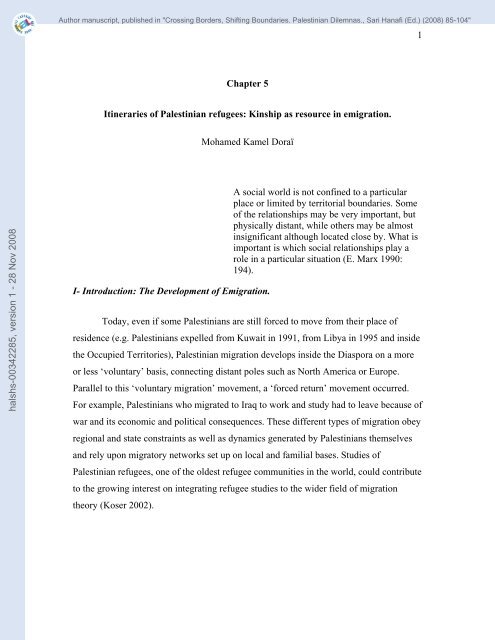
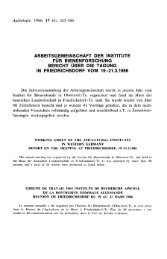

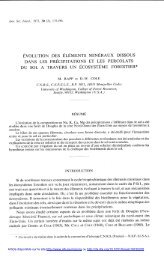
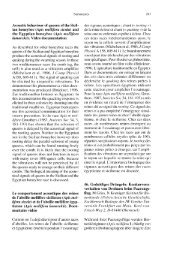
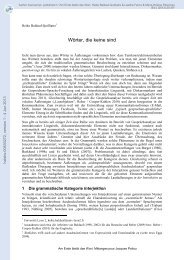
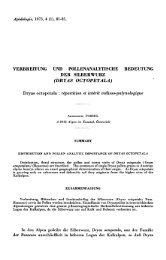
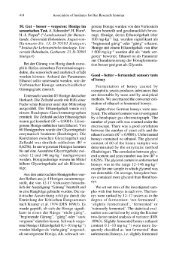
![4 C]-Polyethylenglykol bestimmt, der - HAL - INRIA](https://img.yumpu.com/22454280/1/177x260/4-c-polyethylenglykol-bestimmt-der-hal-inria.jpg?quality=85)
